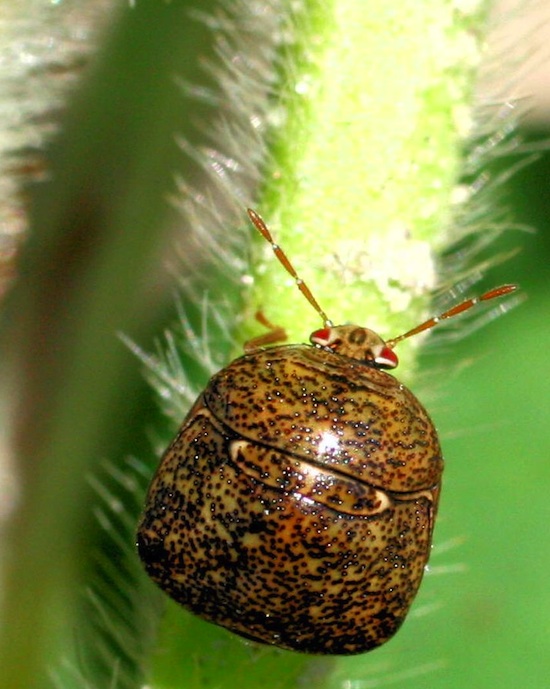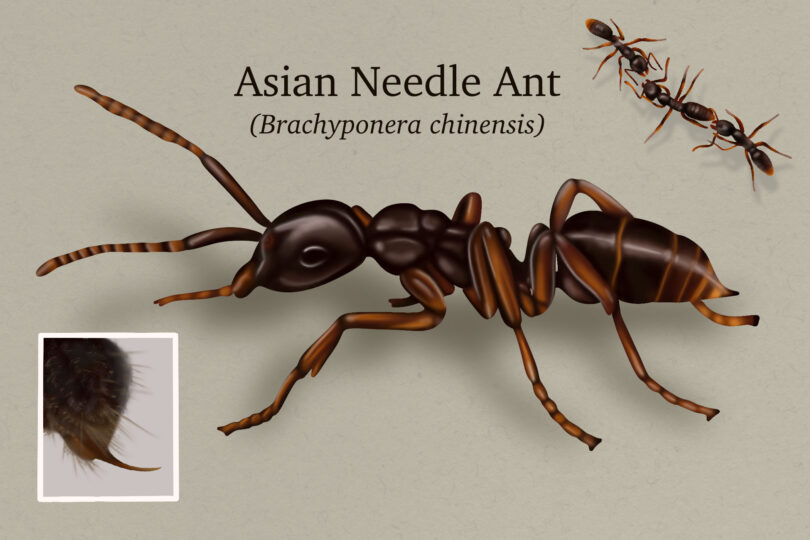Kudzu bugs have awakened from their winter slumber and can be found alighting on just about anything white or light-colored, from small cars to large trucks and homes to commercial buildings. University of Georgia experts say controlling this new pest isn’t as easy as spraying a pesticide.
“These are flying bugs that move from one site to another,” said UGA entomologist Dan Suiter. “You spray the ones you see today and more will come tomorrow.”
Loves kudzu, soybeans
Kudzu bugs, technically called Megacopta cribraria, have green to brown bodies, stipples on their wing covers and wide back ends. A member of the stinkbug family, they can be confused with brown-marmorated stinkbugs or lady beetles, Suiter said. They have a distinct odor that is often mistaken for a natural gas leak. Kudzu bugs feed on Georgia’s most famous weed, kudzu, and other legumes, and they become active in the spring.
If your home is overrun by kudzu bugs, and you want instant gratification, Suiter says you can spray the pests with an over-the-counter, pyrethroid insecticide.
“With pyrethroids, you could put all products in a bag, pull one out, and it'd be just as effective as the 10 products left in the bag. There's little, if any difference, in pyrethroid effectiveness in over-the-counter products,” he said. “If you apply any of these products directly to the bugs, they'll die quickly.”
Look for products that end in '-thrin'
Pyrethroid insecticides can be recognized easily because the name of the active ingredient ends in “-thrin,” Suiter said. Examples of commonly used pyrethroids are bifenthrin, cypermethrin, lambda-cyhalothrin, cyfluthrin and permethrin. Pyrethroid products (sprays, aerosols and granulars) dominate the over-the-counter market and are also common in the professional market.
In January 2013, the U.S. Environmental Protection Agency began severely restricting the use of pyrethroid sprays around structures.
“The bottom line is the EPA wants to keep these insecticides out of water by putting some sensible use restrictions on them (mainly no treatment of flat, hard surfaces where the insecticide can be washed into water),” Suiter said. “These changes will impact use labels for professional pest control operators and homeowners.”
These changes were prompted by emerging data showing that pyrethroid insecticides applied to hard surfaces end up in water where they can be toxic to fish and aquatic invertebrates, he said.
Remove kudzu to remove kudzu bugs
The problem with spot treating kudzu bugs with any pesticide is that unless their food source is removed, more kudzu bugs will arrive soon after to replace the recently deceased. If you can’t or don’t want to remove the pest’s food source — kudzu or soybeans — then the pest is likely to return.
Researchers with the UGA College of Agricultural and Environmental Sciences have been searching for the best control methods since the bug was discovered in Georgia in 2009. In Griffin, Ga., Suiter and his colleagues focus on homeowner control, while in Tifton, Ga., UGA entomologist Phillip Roberts focuses on controlling the pest in Georgia soybean fields. The researchers have found professional grade pyrethroids last longer and are formulated better to control the pest in soybean fields.
“It's not an issue of one product being better than another as much as it is the source of the bugs and what can and cannot be done about the source,” Suiter said.
To help keep kudzu bug numbers down inside your home, UGA experts recommend sealing all cracks an eighth of an inch or wider and spot spraying around all potential entry points with an appropriately labeled residual spray. “These steps are best taken in the fall before the onset of kudzu bug movement,” Suiter said.
Seal windows, doors and vents
In the summer, remove kudzu if possible and make sure all windows are screened, doors remain closed and door sweeps are installed on all exterior doors. Soffit, ridge and gable vents should also be properly screened. In locations where screening cannot be used, such as around pipe penetrations, stuff steel wool into the openings.
To gain relief from insects covering the outside of homes, an exterior wall application of an insecticide spray labeled for outdoor nuisance insect control may be needed, Suiter said.
UGA experts discourage the use of insecticides to control kudzu bugs indoors. Vacuum up the bugs and place the bagged insects in hot, soapy water. “They shouldn’t be crushed because they can stain indoor surfaces, and the resulting odors are difficult to eliminate,” he said.
For more information, search “kudzu bugs” on the UGA CAES publication site at www.caes.uga.edu/publications or visit www.kudzubug.org.








